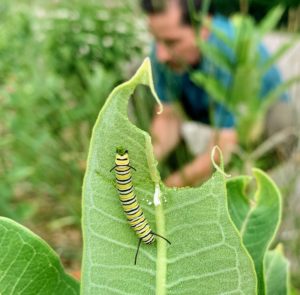The activities are as follows:
- Teacher Guide
- Student activity, Graph Type A, Level 2
- Student activity, Graph Type B, Level 2
- Student activity, Graph Type C, Level 2
- Scientist Profile on Project Biodiversify
- PowerPoint of images
- Data extension activities
- Grading Rubric
With their orange wings outlined with black lines and white dots, monarch butterflies are one of the most recognizable insects in North America. They are known for their seasonal migration when millions of monarch butterflies migrate from the United States and Canada south to Mexico in the fall. Then, in the spring the monarch butterflies migrate back north. Monarch butterflies are pollinators, which means they get their food from the pollen and nectar of flowering plants that they visit. The milkweed plant is one of the most important flowering plants that monarch butterflies depend on.
During the spring and summer months female butterflies will lay their eggs on milkweed plants. Milkweed plays an important role in the monarch butterfly’s life cycle. It is the only plant that monarchs will lay their eggs on. Caterpillars hatch from the butterfly eggs and eat the leaves of the milkweed plant. The milkweed is the only food that monarch caterpillars will eat until they become butterflies.
A problem facing many pollinators, including monarch butterflies, is that their numbers have been going down for several years. Scientists are concerned that we will lose pollinators to extinction if we don’t find solutions to this problem. Doug and Nate are scientists at Michigan State University trying to figure out ways to increase the number of monarch butterflies. They think that they found something that might work. Doug and Nate have learned that if you cut old milkweed plants at certain times of the year, then younger milkweed plants will quickly grow in their place. These new milkweed plants are softer and more tender than the old plants. It appears that monarch butterflies prefer to lay their eggs on the younger plants. It also seems that the monarch caterpillars prefer to eat the younger plants.
Britney and Gabe are two elementary teachers interested in monarch butterfly conservation. They learned about Doug and Nate’s research and wanted to participate in their experiment. The team of four met and designed an experiment that Britney and Gabe could do in open meadows throughout their community.
Britney and Gabe chose ten locations for their experiment. In each location they set aside a milkweed patch that was left alone, which they called the control. At the same location they set aside another milkweed patch where they mowed the milkweed plants down. After a while, milkweed plants would grow back in the mowed patches. This means they had control patches with old milkweed plants, and treatment patches with young milkweed plants. Gabe and Britney made weekly observations of all the milkweed patches at each location. They recorded the number of monarch eggs in each of the patches. By the end of the summer, they had made 1,693 observations!
Featured scientists: Doug Landis and Nate Haan from Michigan State University and Britney Christensen and Gabe Knowles from Kellogg Biological Station LTER.
Flesch–Kincaid Reading Grade Level = 8.2
Additional resources related to this Data Nugget:
- This research is part of the ReGrow Milkweed citizen science project. To learn more, visit their website or follow them on Twitter at @ReGrowMilkweed.
- Britney, one of the scientists in this study, wrote a blog post about her experience in the NSF LTER RET Program (National Science Foundation’s Research Experience for Teachers) working with Doug Landis.
- Learn about how this group of scientists responded to the COVID-19 pandemic to pivot to a virtual citizen science program in this blog post.
- A news article discussing declining monarch populations and the causes that might be contributing to this trend.



These are amazing, but the restriction to PDF format makes ELL translations very challenging, and converting the files within Google Translate is not very effective or accurate.
Hi Rick! Please feel free to email us at datanuggetsk16@gmail.com to request a Microsoft Word file, if that would help!